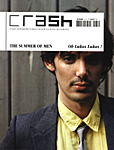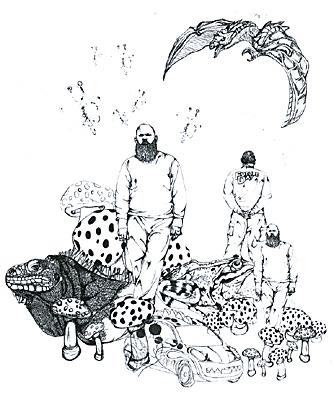| CRASH N°34 |
|
MEETING WALTER VAN BEIRENDONCK |
| You started designing collections again two years ago. Why did you take a break? The last show was in 2000 called "Belief", but actually I was in a really bad way. There was always someone on my back trying to correct what I was doing. It had become a ridiculous situation. They were my financial backers. In the beginning, they were not involved in the collection but then they wanted to get the maximum out of W<. W< was the "jeans" line and there was another more couture line too ? Yes, it really was a second line because I already had my line, Walter Van Beirendonck. I began a commercial collection with them and there was such a large budget, we could do anything we wanted. In just a few seasons, it was no longer simply a second line. It had become an enormous machine and it opened up a lot of possibilities for me. But towards the end it had become too much and I suddenly made the decision to stop. I had a large office with loads of people working for me and I had decided to start again with nothing. I took a break. I worked for nearly two years on the "2001" project in Antwerp. I was the curator of all the exhibitions. I really wanted to escape the fashion world. I visited all museums throughout the world and I got a great deal out of this experience; it made me want to return to fashion. But because I had broken my contract with my financial backers, I couldn't design a collection under my name for five years. Today, I have chosen to work with a very small team. Do you think you can be a designer and independent? Is it viable? When I began in 1985, I was independent. It was very hard to produce a collection every season because it really does cost a fortune. When the money arrived, it gave me freedom. But it is a double-edged sword. I think it is very difficult to combine creativity with money. They are almost contradictory. There are examples of independent designers enjoying great success, like Dries van Noten in Belgium. It's incredible. He is independent but at the same time he is the most organised designer from our genertion; even at college he was already like that! The parallel we can make to fashion is another industry; it is exactly like the film industry. It's just like directors who will make a success of independant films and others who will opt for Hollywood. Yes, you have to make a choice. What would yoo have said to yourself ten years ago with the experience that you have now? Keep yourself at a distance. I was so involved that at one point, when I was producing a show and collections, I was 100% in it. You need to take a step back and have the possibility of seeing it as a job, not something that devours you. It's only fashion, that's what I do. So distance enables clear-sightedness... Yes, and age too. I am 45 years old, remember. I had another attitude at 25. What is your most secret pride ? I am very proud to have always done what I wanted to do and to have always stuck to my guns. I am very direct which is easier said than done in the fashion world. I have my own vision. You are an Antwerp personality. In your opinion, why is Antwerp a source of artists and designers ? Because it's a great place to live; it is easy to find space there. It is at the heart of Europe without the stress of Paris, but it is very close. Every year four or five designers leave the Academy. Antwerp really is full of stylists! That's all there is! Painters too. In my boutique, we organise exhibitions of new emerging artists. But at the same time, Antwerp is above all a place where people work. In other towns, I always have the impression people are playing a role. Here, every person can follow his or her own direction. What do you think of the current scene in Antwerp? Has it changed? Is there a new generation "post-Branquinho. postRaf Simons?" Yes. The most recent newcomers are Peter Pilotto, Christian Wijnants and Bruno Pieters; they are designers that I also sell in my boutique and that I know quite well. There was a first wave with Margiela, Dries van Noten, Ann Demeulemeester and myself, a second wave with Raf Simons, Veronique Branquinho and now there is a third. It is also very pleasing to see that everyone is very faithful to their style and that there are many ambitious people who are going to leave college. Antwerp is a little bit like a laboratory, the "studio" of Europe. |
||
| In the world today, what inspires you most to take a step back? Nature, and I have a 25 year old relationship which counts for a great deal in my life-balance. I live in the countryside and above all I read a lot of books. I am extremely inspired by ethnic tribes; I try to find out all I can on the subject. I also try every season to do a lot of research to find answers I don't have yet, I try to find out and know the greatest amount of information. In your last collection were there ethnic elements? Yes, there was the complete story of the rugs from South Mrica and the Turks who wear rugs with drawings on and I was really struck by the drawings of bombs and planes. I did some research and for them, these drawings are a reference to the Second World War and all the Mricans who went to the frontlines. I picked up this approach and made the drawings and the fabrics. There was also the idea of a contradiction between the hedgehog and the shape of the balls, elements which cannot go together. How do you set' fashion in the future? What do you wish for? For me, the most important thing is to have the possibility to design my collection each season, to produce it and to sell it. I am very pleased with quite small collections; a simple collection which tells a story. I do not live from my fashion but I do not want it to become'a hobby. Another reason why I stopped was because I could no longer create myself, at a certain point, when I was doing five collections: children's wear, shoes, etc. There was always a team and I had to give briefings. Now that I have started designing myself, I choose the fabric, I decide on the colours. It's a lot of work but I love it. Your work is impired by utopia and the future. Do you believe in utopia or in a kind of utopia? Yes, very strongly. For me, it is very important to believe and to have a long-term vision, to have perspectives and to know that things will happen at a certain time, even little things. I really know every process in fashion, I am a teacher and I have a boutique. With all the constraints, it is not easy to take a decision and return to fashion. But it's because I believe in it; it is very important, I can't resist it. People who live in the future are human. Aliens are those who only live in the present. If you are living in the there and now, you lose your humanity. I think so too. And fashion is such a superficial thing that you can easily find yourself in surreal situations. You are inspired a great deal by immediate things like nature, anthropology and humanity; it's quite spontaneous for recharging your batteries. For me, animals are an incredible source of inspiration. I am fascinated by them. I was also fascinated by people who work with their body. I met Orlan and discovered what she was doing in the 1960s. It wasn't because I really wanted to "get" an artist. I was truly interested. We meet and we do things together. Every time, the collections are concept collections. Yes, there is always a story. I try to think of a story, a concept to give a certain direction. I hate talking about colours, fabrics, etc. I prefer to talk about the story around the collection. For me, it is important to use my imagination. The clothes are not enough; I need certain things around me to highlight them and also to distance me from fashion. Occasionally, it is interpreted as a concept. It is a little like a method. Since the first one, I give each collection a name which gives the spirit of the it. |
||

